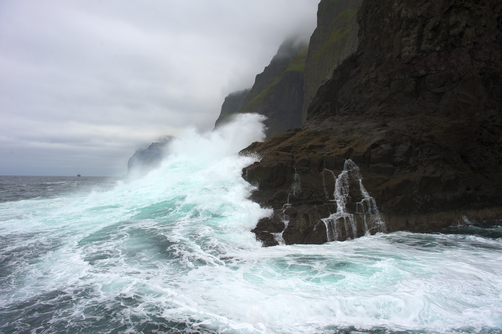OY1CT will be active from Kvivik, Stremoy Island, IOTA EU-018, Faroe Islands in RSGB IOTA Contest, 26 - 27 July 2025.
He will operate in SOAB Category.
Recent DX Spots OY1CT
OY1CT Log search QSL via OY1CT, LOTW.
Ads for direct QSL:
Carsten Thomsen, Uppi I Troed 8, FO-340, Kvivik, Faroe Islands.
Eternity and sheep Faroe Islands
The Faroe Islands formally belong to Denmark, but since 1948 they have been independent in their internal affairs. The center is responsible for foreign policy, justice, and the official currency.
The archipelago holds many mysteries, starting with its name. The name “Faroe Islands” is now associated with the Danish fareyjar, which means “sheep islands.” You would have to look closely at the map for a long time to see a sheep here.
The explanation is simple. The Faroe Islands have belonged to Denmark only since the 15th century, and before that they were part of Norway. However, the first settlers were actually Scots, who were driven out by the Vikings in the early 9th century.
The original name of the islands comes from the Celtic word “fearann,” which means “land.” At that time, many inhabitants of Western and Central Europe spoke Celtic languages. Therefore, it is difficult to say which people gave the islands their name.

Population of the “sheep” islands
Readers will probably be interested in the following figures:
- Number of islands. The archipelago consists of 18 islands, but only 17 are inhabited. Theoretically, there is nothing to prevent the last, 18th island from being inhabited. However, this would require a visa to Denmark. But even without a visa, it is unlikely that anyone would think of looking for a colonist on an uninhabited island.
- The population of all 17 islands is 48,000. If the population were distributed evenly across the islands, each would have approximately 2,580 inhabitants.
- Almost half of the population, about 20,000 people, live in or near the capital. Most of the remaining residents have chosen the main island of Streymøen, where the capital Tórshavn is located, as their place of residence.
There are two official languages in the archipelago: Faroese and Danish. However, the latter was added mainly for legal formalities. Most of the population speaks their native Faroese language and is proud of preserving their ancient culture.
The capital city of Tórshavn
This very old city dates back to 850 AD, when the ancient Scandinavians held their first national assembly. It was a manifestation of democracy that already existed at that time. Unlike today, this form of government was based on the direct participation of every adult in the management of the community.
This was possible due to the small size of the community itself. However, the modern inhabitants of the Faroe Islands are very proud of their history and tend to preserve their ancient democratic traditions.
The inhabitants are also proud of the natural features of the territory in which they have the honor of living:
- Húsarín. This mountain is located northwest of the city and can be seen at any time of the year.
- The mountain is not very high, but this makes it all the more interesting for beginners to climb with virtually no preparation. Local residents remember that it served as a natural defense for the city against possible enemy attacks.
- Kirchuborejn. Another mountain, located to the southwest of the city, with a height of 350 meters. It is high enough to be part of the pleasant landscape outside the window, but not large enough to be a beacon for climbing enthusiasts. However, the locals have lived here since childhood, and it is unlikely that anyone would be particularly frightened by the suggestion of climbing the mountain.
- Sandoa. A river that flows between two mountains. A very beautiful river. The ancient inhabitants of the island believed that the river was animated and had a feminine nature.
Modern residents are very proud of having preserved the historic center of the city. Tingane is located in the heart of the capital and consists of old wooden houses, the oldest of which is over 600 years old.
Soft sheep's wool
The Faroe Islands are fortunate. They are located in the middle of the warm Gulf Stream, so the weather here is mild and warm. Some compare the climate to sheep's wool, which keeps you warm in winter and cool in summer.
In winter, temperatures can drop to zero degrees. Most locals love it when it snows. If it happens at Christmas or New Year, it is considered a good omen. But if there is no snow, the locals do not worry and enjoy the warm and calm weather.
In summer, the temperature reaches 17 degrees Celsius, rarely rising above that. It is not uncommon to see locals wearing light jackets even in summer, but this clothing is worn not so much to keep warm as to show themselves off.
The population of the Faroe Islands cannot be called fashionistas, but sometimes they let their neighbors or just passers-by know about their recent purchases.
Another feature of the local climate is reminiscent of soft sheep's wool.
The Faroe Islands have about 280 rainy days a year, mainly between September and January. The rest of the time, the islands are covered in fog, which prevents the sun's rays from breaking through and thus protects people from overheating.
The local weather cannot be described as sunny or hot. And this is the hallmark of the Faroe Islands.

Not just sheep
Although the name of the archipelago is associated with sheep, other animals are also very interesting here. Seabirds, whales, dolphins — these and other representatives of the animal world are found here in huge numbers.
The flora consists mainly of coniferous trees. This is not surprising, given the local climate. Warm-loving plants would find it very cold here and could only survive in greenhouses.
However, sheep are not only present here as the name of the islands. The last Celts brought sheep here, which over the centuries have spread throughout the archipelago. This even gives some researchers reason to believe that the name is not coincidentally reminiscent of the word “sheep.”
Sights
The capital of the Faroe Islands, bird markets, and small villages, some of which are frozen in their Celtic past, are worth seeing.
Lovers of national cuisine will appreciate the local recipes. The Faroe Islands are famous for their cuisine, which focuses on maximum consumption of meat and fish. Dried lamb and whale blubber are particularly popular dishes. Despite the “fatty” name of the latter, the locals do not get fat from it at all.
The best time to visit the Faroe Islands is in summer, when the weather is moderately warm.

